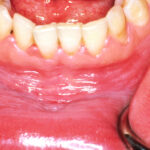
The definition of oral leukoplakia has evolved over the years since the 1978 definition of, “a white patch or plaque that cannot be characterized clinically or pathologically as any other disease” to the 2020 World Health Organization (WHO) Collaborating Centre definition of oral leukoplakia as, “White plaques of questionable risk having excluded (other) known diseases that carry no increased risk for cancer” (Warnakulasuriya et al., 2021). Oral leukoplakia is one of a group of oral potentially malignant disorders (OPMD) with studies reporting prevalence of 4.11% [95%CI: 1.98 to 6.97%] (Dental Elf – 8th Aug 2018) and a potential for malignant transformation of 9.8% [95%CI: 7.9 to 11.7%] (Dental Elf – 25th Jun 2021).
The aim of this review was to assess the prevalence of oral leukoplakia (OLK) reported from 1996 to 2022, and to classify the research into different groups by continent, definition, age, and living habits.
Methods
The review protocol was registered with PROSPERO. Searches were conducted in the PubMed, Embase, Scopus and Web of Science databases from January 1996 to December 2022. Cross-section, case-control, or cohort studies published in English reporting numbers of OLK patients and total population were considered. Two reviewers independently searched for studies with 3 reviewers selecting studies with 2 reviewers evaluating risk of bias using the Joanna Briggs Institute (JBI) critical appraisal tools for prevalence studies. Overall crude prevalence of oral leucoplakia was derived along with meta-analyses for pooled estimates.
Results
- 69 studies involving a total population of 1,263,028; 17,524 with oral leukoplakia.
- The crude overall prevalence rate was 1.39%.
- 28 countries from Asia, Africa, Europe, Oceania, South and North America were represented.
- Three broad groups of studies were identified, population-based, clinic-based and specific population groups (e.g., Soldiers, fisherman etc) and overall prevalence estimates and group estimates from meta-analyses are shown in the table below.
| Type of study | No. of studies | Oral leukoplakia prevalence (95%CI) |
| Population based | 38 | 2.23% (1.44– 3.18%) |
| Clinic based | 12 | 1.36% (0.82–2.02%) |
| Specific populations | 19 | 9.10% (4.85–14.47%) |
| Overall | 69 | 3.41% (2.65–4.26%) |
- The prevalence of OLK in males was estimated to be between 3.9 and 1.8 times higher than females with prevalence estimates for the different groups as shown in the table below.
| Type of study | Oral leukoplakia prevalence (95%CI) | |
| Males | Females | |
| Population based | 5.86% (1.71–12.20%) | 1.50% (0.44–3.14%) |
| Clinic based | 2.29% (0.88–4.31%) | 1.27% (0.55–2.26%) |
| Specific populations | 4.69% (1.71–8.97% | 4.58% (1.24–9.69%) |
- 15 studies investigated the correlation between leukoplakia and tobacco use with 180,898 people out of 641,004 (28.2%) reporting a smoking habit.
- The estimated prevalence of leukoplakia in those reporting tobacco use (regardless of kind or frequency was 9.48 (95%CI: 3.98–16.96) in population-based studies and 9.59 (95%CI: 4.44–16.37) in specific populations.
Conclusions
The authors concluded: –
the prevalence of oral leukoplakia was determined as 1.39% and the pooling estimated global prevalence was 3.41%. The prevalence was relatively consistent and stable across different continents and different definitions. A higher pooled estimated prevalence was found among males, those aged over 60 years old, smokers, and alcohol consumers.
Comments
While a protocol for the review was registered in the PROSPERO database ahtough the code number provided in the main publication is incorrect and the correct link is provided below. Searches were conducted in several major databases although only for a specific time period. In addition, only English language papers were included so potentially relevant studies may have been excluded. This new review included 69 studies providing an estimated pooled global prevalence of 3.41% (95%CI: 2.65 to 4.26%) which is similar to findings from a broader review of a OPMDs in 2018 by Mello et al., (Dental Elf – 8th Aug 2018) which included 22 studies and found a prevalence of 4.11% (95%CI: 1.98 to 6.97%). The authors highlight significant heterogeneity in the included studies and a lack of detail in the included studies relating to definition of leukoplakia, geographical location age, sex, tobacco and alcohol use which needs to be taken into consideration in when interpreting the findings. Future primary studies should be reported in line with the STROBE guidelines and there should be agreement on what factors ( eg age, sex, tobacco and alcohol use etc) should be reported.
Links
Primary Paper
Zhang C, Li B, Zeng X, Hu X, Hua H. The global prevalence of oral leukoplakia: a systematic review and meta-analysis from 1996 to 2022. BMC Oral Health. 2023 Sep 6;23(1):645. doi: 10.1186/s12903-023-03342-y. PMID: 37670255; PMCID: PMC10481497.
Review protocol on PROSPERO database
Other references
Warnakulasuriya S, Kujan O, Aguirre-Urizar JM, Bagan JV, González-Moles MÁ, Kerr AR, Lodi G, Mello FW, Monteiro L, Ogden GR, Sloan P, Johnson NW. Oral potentially malignant disorders: A consensus report from an international seminar on nomenclature and classification, convened by the WHO Collaborating Centre for Oral Cancer. Oral Dis. 2021 Nov;27(8):1862-1880. doi: 10.1111/odi.13704. Epub 2020 Nov 26. PMID: 33128420.
Dental Elf – 8th Aug 2018
Dental Elf – 25th Jun 2021
Photo credits
By Unknown photographer – This image was released by the National Cancer Institute, an agency part of the National Institutes of Health, with the ID 2583. Public Domain
